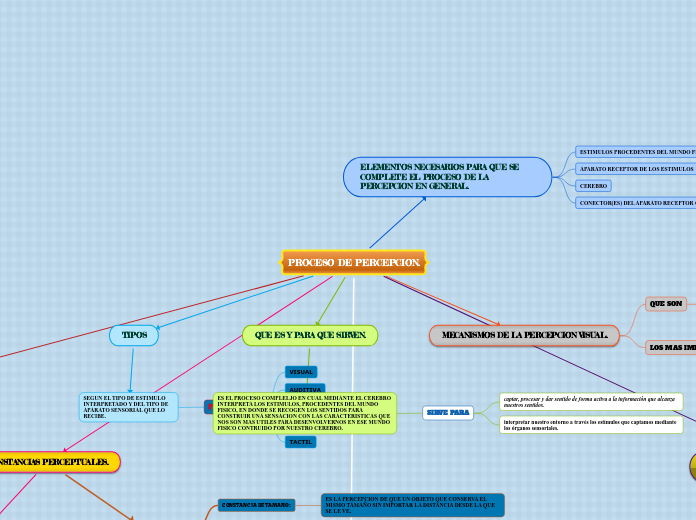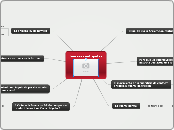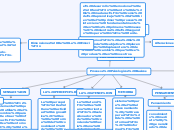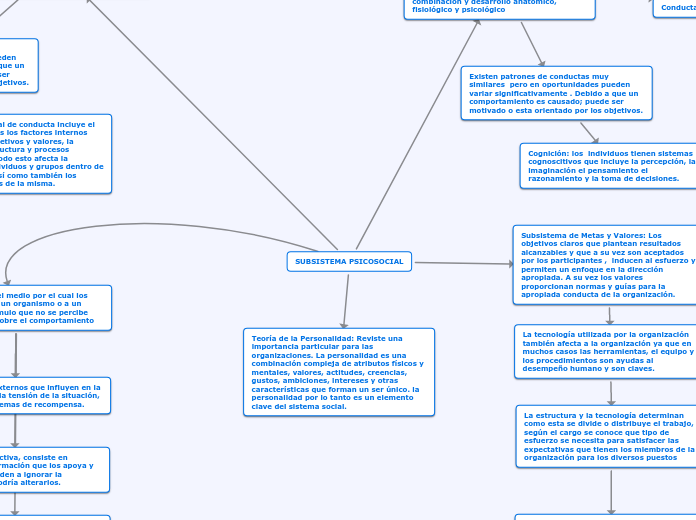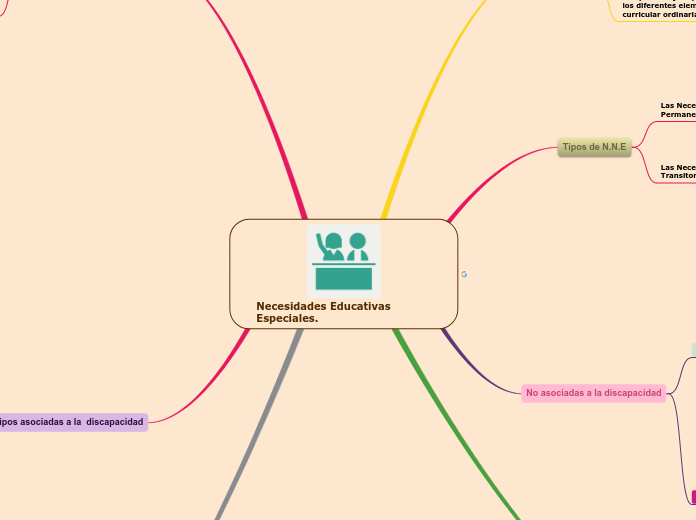PROCESO DE PERCEPCION.
To name your story, you have to think about the overall message and what you want your audience to understand from the story. Also, make it relevant and easy to remember.
PERCEPCION DEL MOVIMIENTO Y LAS ILUCIONES VISUALES.
QUE SON LAS ILUCIONES OPTICAS:
UNA ILUCION OPTICA ES CUALQUIER ILUSION DEL SENTIDO DE LA VISION QUE NOS LLEVA A PERCIBIR LA REALIDAD DE VARIAS FORMAS.
LAS ILUCIONES PERCEPTUALES SON:
AQUELLOS FENOMENOS EN LOS QUE EL ESTIMULO PERCIBIDO NO SE CORRENPONDE CON EL ESTIMULO DISTAL LLAMDO OBJETO REAL.LOS FENOMENOS ILUSORIOS EN PERCEPCION NO SE PRODUCEN EXCLUSIVAMENTE EN EL MUNDO VISUAL.
SIN EMBARGO, ESTAS ILUSIONES SON LAS MAS CONOCIDAS E INTERESANTES.
LOS ORGANOS QUE PARTICIPAN EN LA PERCEPCION DEL MOVIMIENTO SON:
LOS OJOS:
SON PRINCIPALMENTE LOS ORGANOS MAS IMPORTANTES YA QUE LOS OJOS PERMITEN OBSERVAR LOS CAMBIOS QUE OCURREN EN NUESTRO ENTORNO.
EL MOVIMIENTO SE PERCIBE:
POR RL PRIMER PASO EN LA PERCEPCION DEL MOVIMIENTO ES QUE EL SISTEMA VISUAL ESTIME EL MOVIMIENTO A PERCIBIR.
CUANDO EL DESPLAZAMIENTO DE UN OBJETO O UN PUNTO EN EL ESPACIO, SE REFIERE AL MOVIMIENTO REAL .QUE EXISTEN VARIOS DESPLAZAMIENTOS DE LOS OBJETOS QUE NO PODEMOS PERCIBIR PORQUE ESTAN DEBAJO DE NUESTRO UMBRAL DE DETECCION DEL MOVIMIENTO.
Y EN DONDE EL MOVIMIENTO SE PERCIBE MEDIANTE DOS MECANISMOS, UNO BASADO EN LA DETECCION DEL MOVIMIENTO DEL OBJETO A OBSERVAR
Y EL OTRO BASADO EN ELMOVIIENTO DE LA CABEZA Y LOS OJOS.
PERCEPCION DE DISTANCIA Y PROFUNDIDAD.
TIENEN COMO CARACTERISTICA DOS PERCEPCIONES O SEÑALES LLAMDAS: SEÑALES MONOCULARES Y SEÑALES BINOCULARES:
SEÑALES BINOCULARES:
CONVERGENCIA: SEÑAL VISUAL DE PROFUNDIDAD QUE PROVIENE DE LOS MUSCULOS QUE CONTROLAN EL MOVIMIENTO OCULAR CUANDO LOS OJOS GIRAN HACIA EL INTERIOR PARA VER UN ESTIMULO CERCANO.
DISPARIDAD RETINIANA: DIFERENCIA ENTRE LAS IMAGENES PROYECTADAS SOBRE LAS DOS RETINAS CUANDO AMBOS OJOS ESTAN ENFOCADOS EN EL MISMO OBJETO:
VISION ESTEREOSCOPICA: COMBINACION DE DOS IMAGENES RETINIANAS PARA PRODUCIR UNA EXPERIENCIA PERCEPTUAL TRIDIMENSIONAL.
SEÑALES MONOCULARES:
PARALAJE DE MOVIMIENTO: LOS OBETOS MAS CERCANOS PARECEN MOVERSE MAS RAPIDO QUE LOS QUE ESTAN A MAYOR DISTANCIA.
PERSPECTIVA LINEAL: DOS LINEAS PARARELAS PARECEN UNIRSE EN EL HORIZONTE.
GRANDIENTE DE TEXTURA: LOS OBJETOS VISTOS A MAYOR DISTANCIA PARECEN SER MAS TERSOS Y CON MENOR TEXTURA.
PERSPECTIVA AEREA: ES PROBABLE QUE LOS OBJETOS MAS DISTANTES APAREZCAN BRUMOSOS Y BORROSOS.
CONSTANCIAS PERCEPTUALES.
TIPOS DE CONSTANCIAS:
CONSTANCIA DE COLOR:
SON SON LOS OBJETOS FAMILIARES CONSERVAN SU COLOR A PESAR DE LOS CAMBIOS EN LA INFORMACION SENSORIAL.
CONSTANCIA DE FORMA:
TENDENCIA A VER UN OBJETO DE LA MISMA FORMA SIN IMPORTAR DESDE QUE ANGULO SE VEA.
CONSTANCIA DE TAMAÑO:
ES LA PERCEPCION DE QUE UN OBJETO QUE CONSERVA EL MISMO TAMAÑO SIN IMPORTAR LA DISTANCIA DESDE LA QUE SE LE VE.
QUE ES:
LA CONSTANCIA PERCEPTUAL SE REFIERE A LA TENDENCIA DE PERCIBIR LOS OBJETOS COMO RELATIVAMENTE ESTABLECES E INALTERABLES A PESAR DE LOS CAMBIOS EN LA INFORMACION SENSORIAL.
ORGANIZACION PERCEPTUAL.
ALGUNOS DE SUS ELEMENTOS CUMUNES PERO IMPORTANTES BASICOS SON AQUELLOS QUE MAS ACAPTAMOS DEL MUNDO FISICO POR EJEMPLO:
PERCEPCION.
SENSACION.
FONDO: ES LA PARTE TRASERA O LOS ESPACIOS DEL OBJETO.
FIGURA: ES EL OBJETO PERCIBIDO.
SON LOS PRINCIPIOS QUE NOS DESCRIBEN LA FORMA DE COMO ORGANIZAMOS FRAGMENTOS Y PARTES DE INFORMACION EN CONJUNTO SIGNIFICATIVOS.
POR EJEMPLO:
PROXIMIDAD
SIMPLICIDAD
SEMENJANZA
CIERRE
MECANISMOS DE LA PERCEPCION VISUAL.
The ending of a story is essential. We all know that if the ending is weak, what happened before loses its importance. So make it unpredictable, but fair. A resolved ending answers all the questions and ties up any loose threads from the plot.
LOS MAS IMPORTANTES SON:
This is the closure section of the story.
See examples of possible outcomes below:
- all problems have been solved
- it's clear how each one of your characters ends up
- your main character is transformed by the challenge
SEGUN LAS CARACTERISTICAS DEL MUNDO FISICO SON AQUELLAS DOS:
Try answering these questions to come up with a closure:
- Have all the problems been solved?
- Is there a clear picture of what happens with each character in the story?
- Has the challenge transformed your main character?
- How do the characters feel in the end?
MEMORIZACION Y RECONOCIMIENTO.
PERCEPCION DE
EL MOVIMIENTO
LA 3°DIMENSION.
LA FORMA
EL COLOR
QUE SON
This is the moment when the main character surpasses the last obstacle and finally faces their greatest challenge.
The climax usually follows one of these patterns:
- realization
- resolution
- choice
Type in your answer.
MODOS O PATRONES DE INTERPRETACION DE LOS ESTIMULOS PROCEDENTES DEL MUNDO FISICO.
ELEMENTOS NECESARIOS PARA QUE SE COMPLETE EL PROCESO DE LA PERCEPCION EN GENERAL.
The middle of the story is where you add layers of complications that will lead to the end. Reveal more about the character's journey. Did their personality go through changes? How did they overcome the challenges? And as you build up the story’s central conflict, make it more personal to that character. Also, from the middle act, you have to lead into the final act.
CONECTOR(ES) DEL APARATO RECEPTOR CON EL CEREBRO.
There wouldn't be any tension and excitement in your story if there weren't any obstacles in your character's way.
CEREBRO
Your character(s) need(s) motivation in order to solve the challenge(s).
APARATO RECEPTOR DE LOS ESTIMULOS
Type in any other challenges which other characters in the story need to face.
ESTIMULOS PROCEDENTES DEL MUNDO FISICO
Each story has a main character and that character usually needs to solve a problem or challenge. The character's challenge is the one that creates tension throughout the story.
QUE ES Y PARA QUE SIRVEN.
ES EL PROCESO COMPLELJO EN CUAL MEDIANTE EL CEREBRO INTERPRETA LOS ESTIMULOS, PROCEDENTES DEL MUNDO FISICO, EN DONDE SE RECOGEN LOS SENTIDOS PARA CONSTRUIR UNA SENSACION CON LAS CARACTERISTICAS QUE NOS SON MAS UTILES PARA DESENVOLVERNOS EN ESE MUNDO FISICO CONTRUIDO POR NUESTRO CEREBRO.
The setting (time & place) of a story can change throughout the plot.
SIRVE PARA
Your story can take place wherever your imagination will take you to.
For example: in an elevator, in an enchanted forest, etc. Don't forget to give details of the environment each time the setting changes, otherwise, the story can be confusing. Also, mention the seasons as each of them has unique weather and events.
interpretar nuestro entorno a través los estímulos que captamos mediante los órganos sensoriales.
captar, procesar y dar sentido de forma activa a la información que alcanza nuestros sentidos.
TIPOS
SEGUN EL TIPO DE ESTIMULO INTERPRETADO Y DEL TIPO DE APARATO SENSORIAL QUE LO RECIBE.
In the beginning of the story (or the exposition), you will need to introduce the setting and characters. You might also want to introduce the main conflict. This part of the story is important because it gives the reader necessary background information and maybe even a first insight into a character’s personality.
PERCEPCION
Type in the name of your character.
TACTIL
Add other properties of the character.
GUSTATIVA
Add other qualities/attributes of the character.
OLFATIVA
What is your character's main goal?
fight Evilfind lovedefeat his/her enemyrule the worldmake friendstime travelmake an awesome discoveryOther
AUDITIVA
Which traits best describe the character's personality? Choose more if necessary:
introvertedloyalkindindependentquick-thinkingadventuresomeidealisticsweet-naturedcalmrisk-takercreativewittystrictfussyweirdclumsyharshaggressivecarelessclingingcowardlycrueldeceitfulimpulsiveOther
VISUAL
Choose the type of your chacter:
Protagonist (main character)Antagonist (main character's opponent)Flat (stereotypical character)Round (his/ her personality develops throughout the story)Static (doesn't evolve as a person throughout the story)Dynamic (dramatical change in personality)Confidant (the main character trusts him/ her)Foil (contrasting character who enhances the personality of another character)Other
